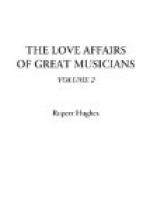The relations of Wagner and Cosima rapidly grew intimate enough to torment even the idolatrous Von Buelow. Riemann says: “Domestic misunderstandings led, in 1869, to a separation, and Von Buelow left the city.” One of the “domestic misunderstandings” was doubtless the birth of Siegfried Wagner, June 6, 1869. A speedy divorce and marriage were imperative. The chief difficulty in the securing of the much desired divorce was that Cosima must change her religion, or her “religious profession,” to use the more accurate phrase of Mr. Finck, who says that Wagner in his life with her, had “followed the example of Liszt and Goethe and other European men of genius, an example the ethics of which this is not the place to discuss.”
Von Buelow secured his divorce in the fall of 1869. He remarried, in 1882, the actress, Marie Schanzer. Wagner and Cosima were married August 25, 1870. This was the twenty-fifth birthday of King Ludwig, and Glasenapp comments glowingly upon the meaning of the marriage:
“To the artist, who in the first great rumblings of the war of 1870-71, greeted the dawn of a new era for his people, the same hour proved to be the beginning of a new chapter. On Thursday, the 25th of August, 1870, in the Protestant Church of Lucerne, in the presence of two witnesses, one, the lifelong friend of the Wagner family, Hans Richter, the other, Miss M.v.M., the wedding of Richard Wagner to Cosima, the divorced wife of Hans von Buelow, was celebrated.
“There is no other union which Germans ought to deem more holy. None have ever been entered into with less selfishness, with higher impersonal sentiments. It united the great homeless one, who had suffered so much and so long under the heartlessness and unappreciative neglect of his contemporaries, to a wife, who stood beside the friend of her father, the ideal of her husband, with cheerful encouragement (mit theilnahmvollster Sorge), until she as well as her husband realised that she was the one chosen to heal the wounds which the artist had suffered in his restless wanderings and through numberless disappointments. The time had arrived when the hand of love prepared the last and never-to-be-lost home.
“This knowledge gave the noble-minded woman the courage to sever the ties, which in early youth had tied her to one of our most eminent artists, and the best of men; to give up herself to her task, to consecrate her life to him, to be the helpmeet of the man to whom through friendship and the inner voice of her heart, and the knowledge of noble duty, she had already belonged. The world did not hesitate to malign this holiest act of fidelity. Only the small and the low are overlooked, the high and the great are ever the victims.”
Just two months before the marriage, Wagner had written to Frau Wille, who had invited him and his wife-to-be to visit her, an account of his feelings in the matter, which is beautiful enough and sincere enough to quote at some length:




